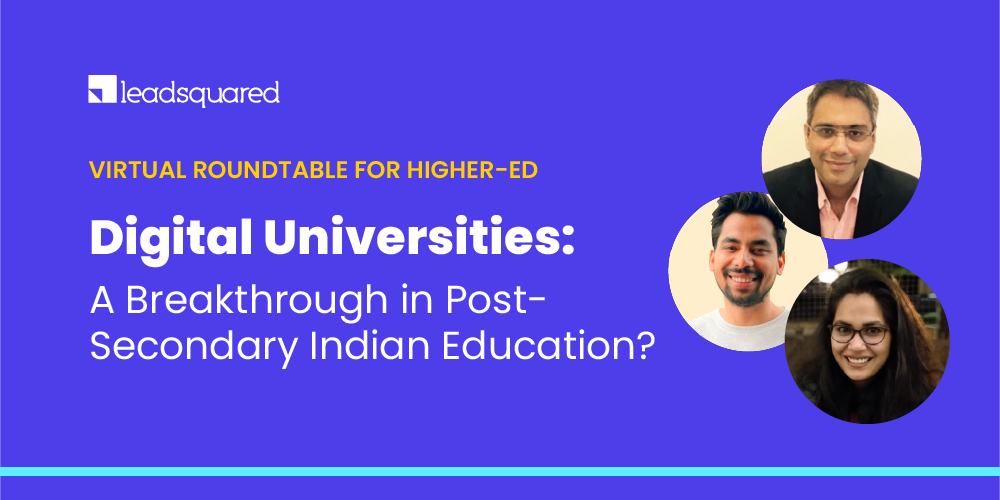India’s top universities rank near 350 in terms of global university rankings. Universities were obliged to shift to digital learning during the pandemic. This also gave rise to numerous online universities.
In this new system, fewer traditional teaching techniques are being used in universities, but there is increasing use of digital teaching techniques. The courses universities offer are heavily focused on improving employability. We analyze the results and impacts of digital universities in this webinar with three great speakers and industry experts:
- Gaurv Bhatia, CEO, Rise
- Rajeev Pandey, Deputy Director – Marketing, Edology
- Jagruti Bhargav, Senior Ed-Tech, Marketer, LeadSquared
Can digital universities replace traditional education?
The classroom has long served as the boundary of the educational universe. But these days, students can learn from wherever they want, thanks to digital and technological education.
The traditional teaching approach has long been used in educational institutions. The traditional paradigm, in which fifty students are being taught by one teacher at once, is one that most of us are familiar with.
However, nobody has any idea how well those fifty students can comprehend the material or even if they are paying attention to the lecture. Today, it’s not considered as an effective method of teaching.
Students now have access to modern technology that greatly improves how well they absorb knowledge. Therefore, it is necessary for educational institutions to adapt their teaching strategies. Online learning, also known as eLearning, is a well-liked substitute for traditional education.
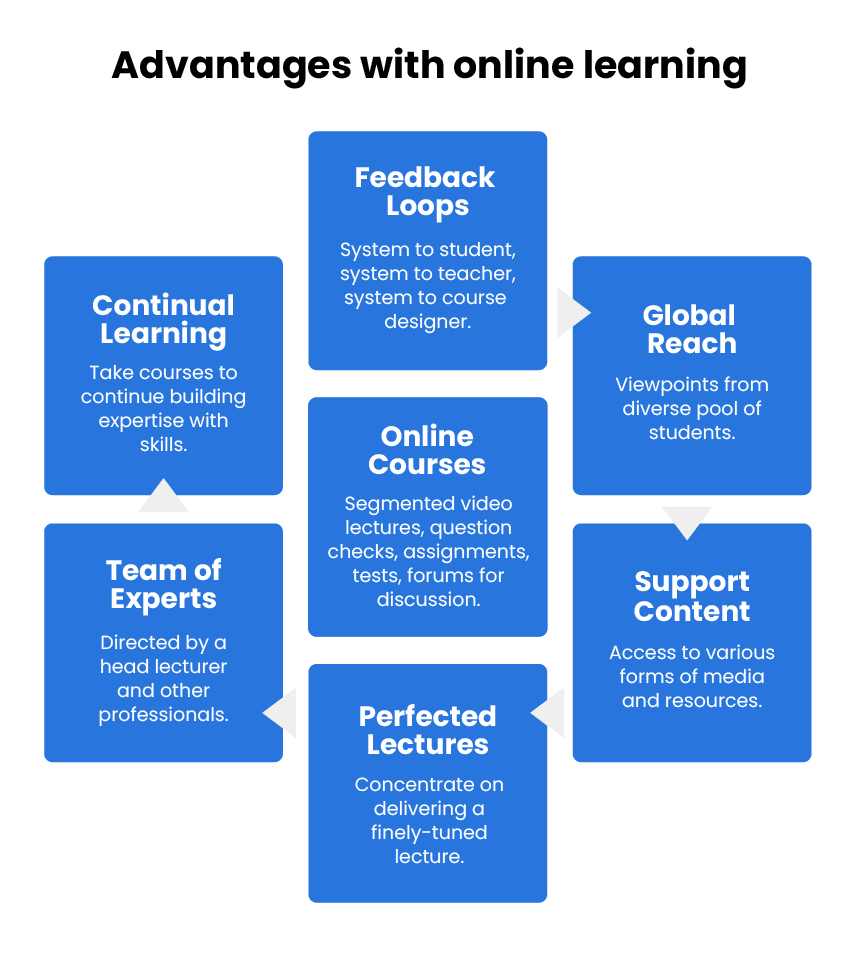
Whether online education is superior to traditional education or not is up for debate. In essence, the online education model seeks to improve upon the drawbacks of the conventional educational system while simultaneously adding new advantages.
In a traditional educational setting, pupils sit through protracted lectures, take notes, and frequently rely on rote memorization.
There is little to no room for in-depth discussion in the classroom as a result. On the other hand, online education promotes peer-to-peer communication and involvement in class activities.
“Overall, digital literacy has increased dramatically, giving people more control over the information they consume and how they consume it. This has made it easier for people to find alternative forms of learning. People can learn new skills quickly and reshape their resumes. This is because of the accessibility of digital resources.”
Rajeev Pandey, Deputy Director – Marketing, Edology
How does technology affect learning for students?
We hear a lot about how too much screen time can be bad for students, but we should also consider how technology has had a positive impact by becoming part of the curriculum.
Not only has technology increased student involvement, but it has also helped teachers improve their lessons and promote personalized learning. Additionally, it has assisted learners in developing the abilities necessary for their development.
Online classroom software that incorporates video, augmented reality, and other forms of technology not only makes the classes engaging but also fosters inclusion, encourages cooperation, and elevates technology as a goal in and of itself.
A recent financial express survey found that 87% of organizations are already dealing with or anticipate dealing with a talent shortage. After the pandemic, the employment environment altered, and trending technologies like full-stack, data science, artificial intelligence, machine learning, and others are now required in job descriptions.
These are practical skills that require students to work directly with professionals in business.
Various methods can help students learn more effectively, such as:
- Group study and collaboration between students.
- Students can pick their own pace for learning.
- Students may participate in project-based learning.
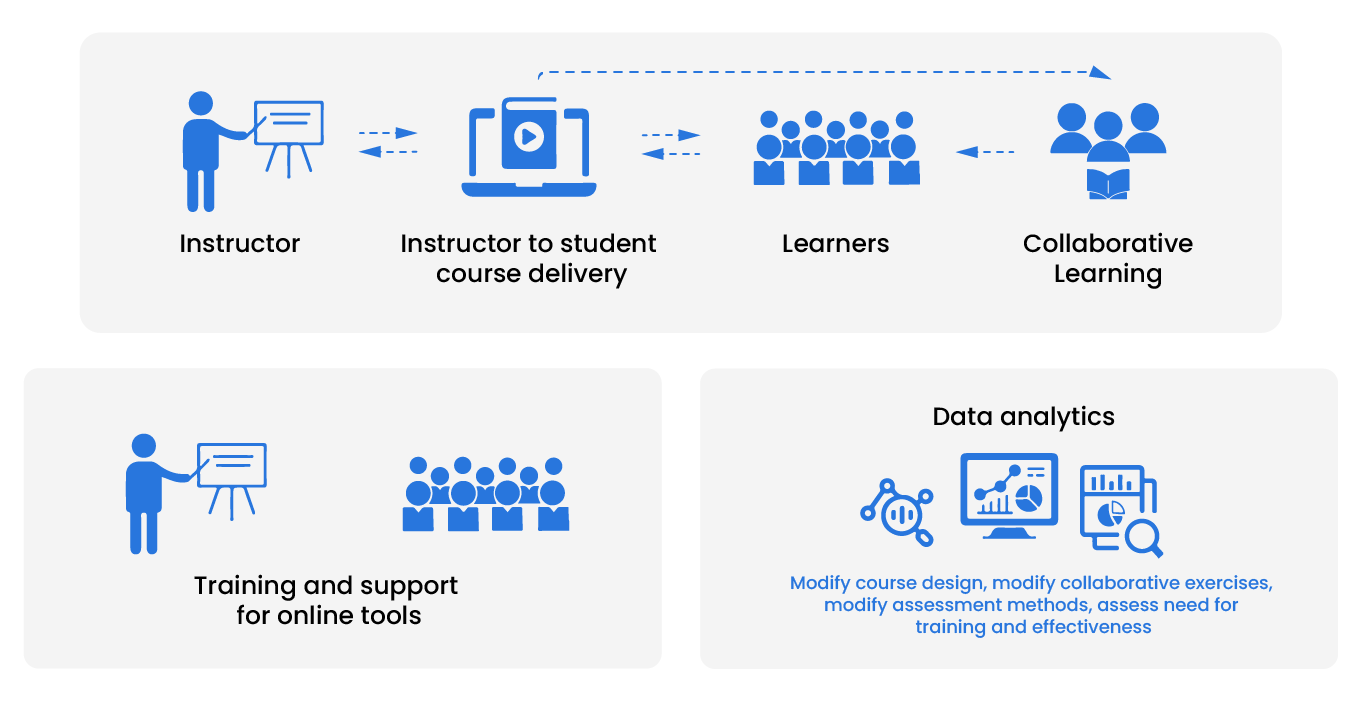
This figure shows how to use online tools effectively. It includes an instructor delivering content to students, student collaboration, tool training, and data analytics for the ongoing course and assessment method improvement.
“With the rise of digital learning, there has been a lot of change in how to leverage data and shape the entire learning process. This has allowed for a more personalized form of learning for students on a larger scale.”
Rajeev Pandey, Deputy Director – Marketing, Edology
Technology will continue to change the world for the better. The educational sector is anticipated to experience greater transformation soon in order to support and assist the notion that education is for everyone.
Lifelong learning is important, but is alternative education the best way to achieve it?
It is thought that whenever an event happens, it changes the behavior of people in many ways.
In short, the traditional education system was disrupted by Covid-19, and people were forced to find other ways to learn. This led to the emergence of many new startups providing alternate forms of learning.
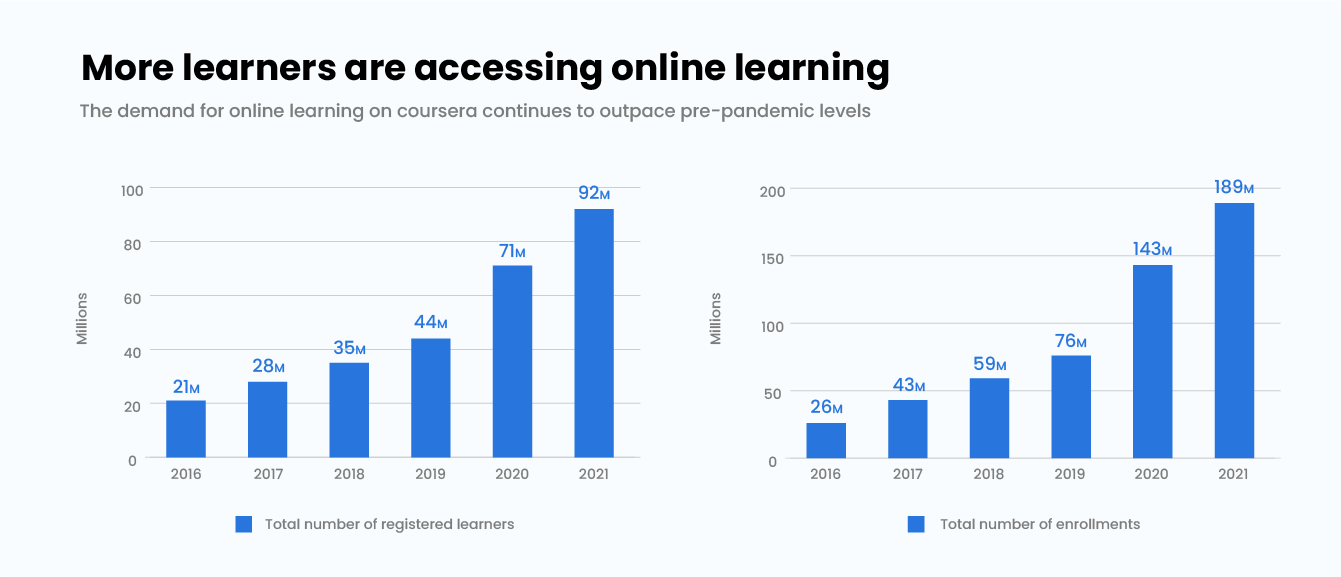
Now, lifelong learning has become a norm, and people are more open to trying new opportunities for learning.
People are talking about the sudden increase in knowledge and how it has led to a change in people’s habits. More people are using Twitter as a learning tool and OTT platforms are providing educational content that is getting a lot of views.
Digital education is more accessible and equitable, as people can learn at their own pace and time. Additionally, it is more cost effective for employers, as there are no associated costs with running a program.
What can traditional universities learn from digital universities and edtech?
There are many ways that traditional universities and digital universities can work together to improve the educational experience for students.
One way is by using technology to complement classroom learning. This can include using digital resources to supplement classroom content and using online tools to measure student engagement and progress.
EdTechs and digital universities are also better equipped at using data to comprehend what student wants.
For instance, 70% of the educators have a fair understanding of the student journey.
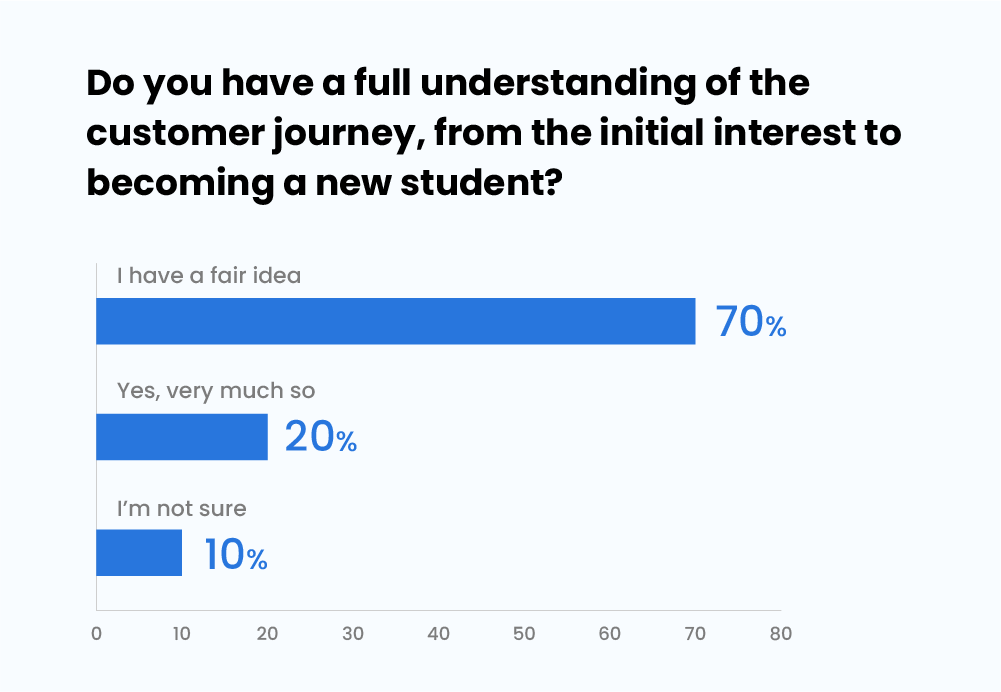
It goes without saying, digital tools can make things a lot easier for educators. But it’s equally important to strategize your approach.
What strategy should institutions use to scale up their online capabilities?
- Plan a defined online education approach that makes use of staff expertise and experience while also incorporating provisions for the development of new skills.
- Think about the benefits of collaborating with independent EdTech and online service providers.
- Align online learning practices with programs that are campus-based, hybrid, or blended.
The tool stack needed to start a digital university
Helping students get enrolled in the courses of their choice in a timely manner can eventually assist in their career pursuit.
But are counselors equipped with necessary tools to converse and enroll prospective students?
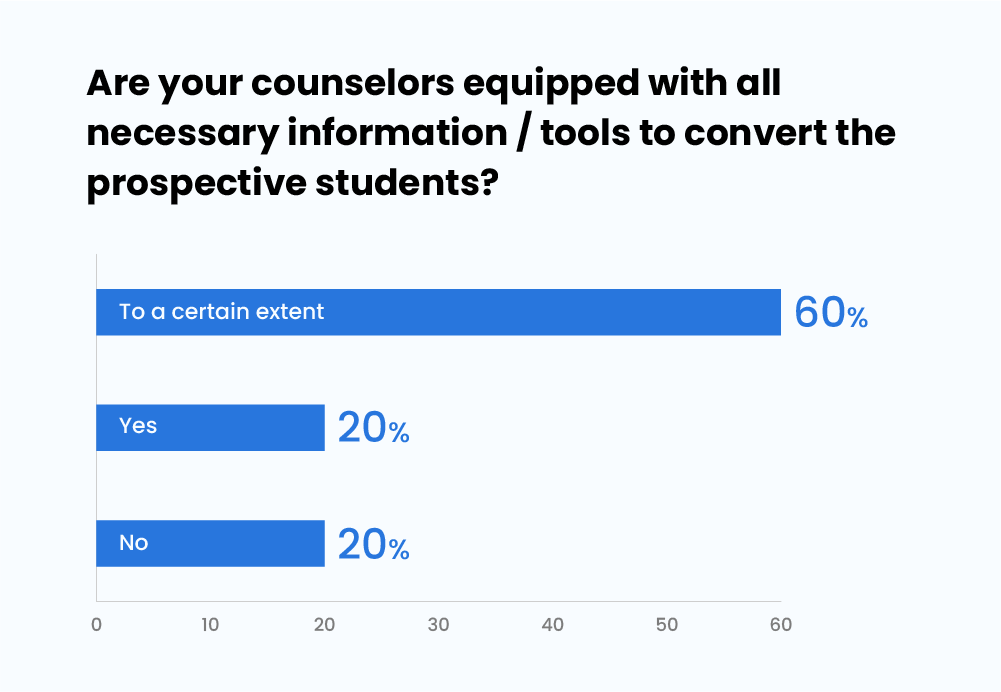
When building a digital university, it is important to think about the entire life cycle of the student. This includes everything from the time the student identifies your program, to the time the student has completed their learning and is looking for jobs and employability in the future.
It is important that all these different pieces work together seamlessly in order to create a successful digital university.
“It is important to have a CRM like LeadSquared in place in order to manage student information and ensure that all students are coming from valid sources. Additionally, it is important to consider what problem you are trying to solve and how you can use complementary partnerships to solve that problem.”
Gaurv Bhatia, CEO, Rise
Let’s make a list of the essential tools for creating a digital university that will offer seamless connectivity to all participants.
Student Portal– The student portal acts as a centralized platform that links students, parents, and instructors as well as several critical services, spanning the whole student life cycle from registration and learning through payment and involvement.
We did a survey, asking 45 attendees what is the most important KPI for their admission team and 38% of them voted for connection rates.
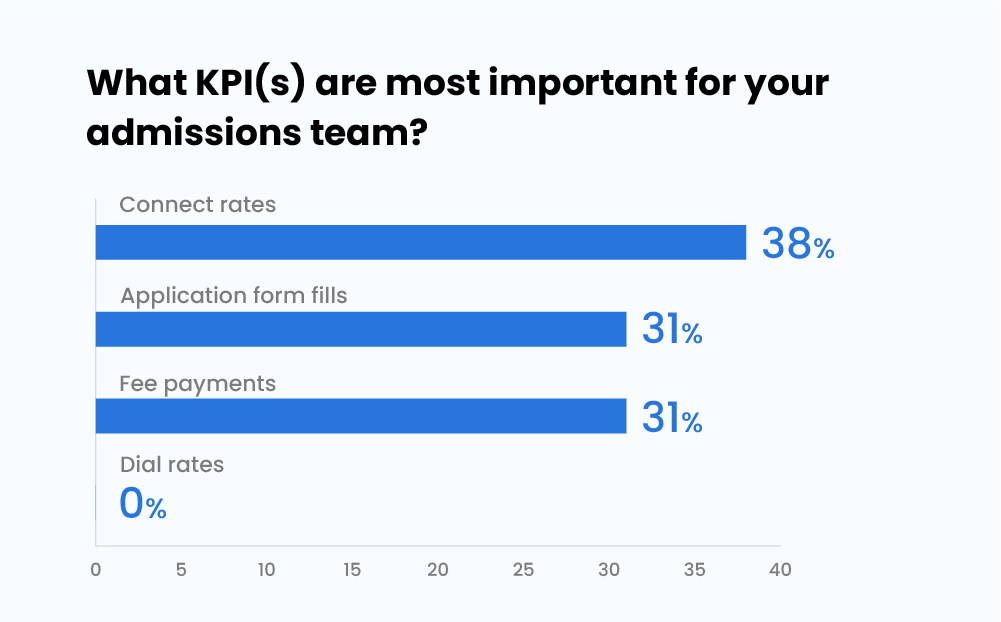
Student portals should be designed with users in mind, much like consumer portals are, in order to give students linked, highly personalized experiences and to ease the academic staff’s everyday tasks.
An Enrollment System– With a system like this, the entire enrollment is covered, and it helps to speed up the application process, streamline student acceptance procedures, and ensure that no request is overlooked.
The enrollment platform will act as a portal’s entry point for prospective students and offer information about their preferences and behavioral patterns after it has been implemented.
A Learning Management System– The core of the whole online learning process can be an LMS or learning management system.
Students may design workflows to organize their learning and interact with other integrated platforms, tools, instructors and other students using the tools of their choice thanks to the system.
The Higher Education CRM from LeadSquared gives you all the resources you require to increase enrollments. Book a 15-minute demo with us!
Audience Questions
Yes, in general, the move to online learning is seen as positive by educational institutions. The main benefits are that it allows for a more customized and tailored approach to learning and that it can be more engaging for students. Additionally, the ability to start with live content and then move to recorded content can help to build engagement and enthusiasm for the material.
When looking at implementing an online learning platform, there are a few key things to keep in mind. Firstly, you need to have a CRM in place to manage student data. Secondly, you need to identify what kind of learning management system (LMS) you require. Thirdly, you need to think about how you will conduct examinations and how students will be supported.
Lastly, you need to consider how certification will be handled. All these factors need to be considered when choosing an online learning platform.
Speakers

Gaurv Bhatia
CEO, Rise

Rajeev Pandey
Deputy Director – Marketing, Edology

Jagruti Bhargav
Senior Ed-Tech, Marketer, LeadSquared





